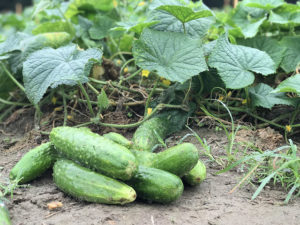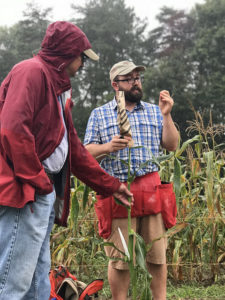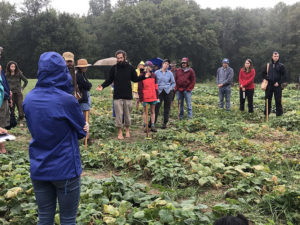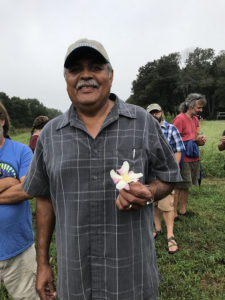USA
September 18, 2018
 Cucumbers from an organic variety trial in Louisa, Virginia
Cucumbers from an organic variety trial in Louisa, Virginia
Last week Organic Seed Alliance was in Virginia to help lead an on-farm plant breeding course hosted by the Northern Organic Vegetable Improvement Collaborative (NOVIC). More than 40 participants joined from across the Southeast, including Florida, Virginia, North Carolina, and West Virginia. The two-day intensive was co-hosted by Southern Exposure Seed Exchange and Common Wealth Seed Growers. Two additional seed companies in the region, Sow True Seed and the Southern Heritage Seed Collective of Working Farms, also participated.
NOVIC instructors included Jim Myers of Oregon State University, Michael Mazourek of Cornell University, and OSA’s Micaela Colley and Jared Zystro. The intensive covered the basics of organic plant breeding strategies and techniques for self- and cross-pollinating crops, and included instruction on developing breeding goals for organic systems. Instructors provided hands-on demonstrations in squash, cucumber, tomato, peppers, and beans.
 "
"
OSA’s Jared Zystro talks about on-farm plant breeding techniques in sweet corn
Edmund Frost of Common Wealth Seed Growers gave a tour of his extensive cucurbit breeding program focused on disease resistance for organic systems, providing participants an applied example from the field. Participants also toured seed production fields planted to an array of vegetables, herbs, and flowers. One highlight of the event was learning about the close partnership between Edmund and Cornell breeder Michael Mazourek, as they described the value of their collaboration. The breeding partners have worked together for five years on cucurbit variety trials and breeding projects to deliver some of the most exceptional downy mildew resistant cucumbers on the market (find some of them here). Edmund recently received a grant from the Organic Farming Research Foundation to continue his cucumber and melon trials for identifying resistance to both downy mildew and bacterial wilt.
Participants not only learned from listening to the trainers and other participants, but by applying their learning through an exercise that involved designing their own breeding project. Individuals then shared their breeding projects with the group, including their description of breeding goals, breeding techniques, germplasm selections, and why their project was valuable to society.

Edmund Frost of Common Wealth Seed Growers gives a tour of his organic cucurbit plant breeding projects focused on downy mildew resistance
As instructors, we learned from participants, too. Another highlight included participants sharing knowledge and stories about historical crops in the region, including cotton and peanuts, which have declined in production and diversity over the last 50 years. One of the farmer participants, Clifton Slade, grew up on a peanut farm and shared how farmers always selected their best seed stock for replanting, including picking pods with three or more peanuts rather than just two, and selecting for disease-free plants and yield. He said his family’s farm made gains from selection each year. Peanuts are a leguminous self-pollinating crop adapted to the region, but within the species there is a range of maturity times and cold and disease tolerance. So, knowing which type to plant was essential knowledge within a region. A Georgia peanut, for example, might not grow well in Virginia where cool fall temperatures might not mature the seed.

Clifton Slade of Slade Farms in Surry, Virginia, attended the intensive and provided some agricultural history of the region. Here he’s holding a cotton bloom.
Cindy Conner, another Virginia grower, shared her experience collecting and conserving genetic diversity in cotton. She showed how to remove the seed from the cotton plant, and how a natural range of colors can be in one line of cotton. This means a single yarn can display a beautiful pattern of color.
There continues to be a collective energy for seed emerging in the Southeast. Participants enthusiastically discussed the need to build more networks for coordinated trials and breeding projects. One next step is to explore opportunities for hosting a Southeast seed summit to continue conversations and grow the momentum behind this work.
After we left Virginia, Hurricane Florence hit the region hard. Our hearts go out to everyone affected by the hurricane. We know that many farmers and other community members are currently dealing with the aftermath of powerful winds and rain. We send our love and support.